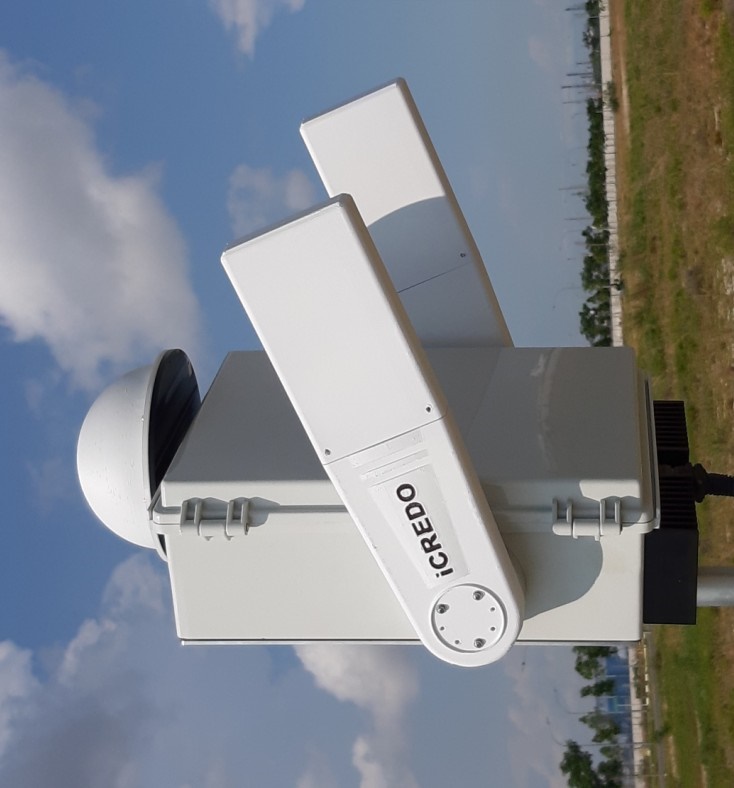 INTRODUCTION
INTRODUCTION
Technological advancements in commercial drones have presented a new threat to the de-fence and private communities. Intrusions into key installations and strategic assets like air and naval bases and army camps pose security breaches. Damage can range from political em-barrassment to terrorist-styled destruction using home-made bombs delivered by drones. Intru-sion of drones into private properties becomes an invasion of privacy. VIPs can also be threatened by drones equipped with firearms, grenades and bombs.
 emASPIDA
emASPIDA
iCREDO has developed a new generation drone jammer, emASPIDA, that proves to be a game changer. Fig. 1 shows two versions of emAS-PIDA mounted in the field. ASPIDA is a Greek word for shield. emASPIDA creates an electro-magnetic shield that prevents drones from ap-proaching and intruding. ASPIDA is also the acronym for Air Space Protection against Infinite Drone Attacks. This implies emASPIDA can handle drone swarm attacks within its antenna coverage. Fig. 2 shows how this jammer can be deployed to protect an area against drone intru-sions, operating 24/7. As drones approach the shield, they will lose RC control and video links will be cut off. GNSS is also denied. Hence, drones will hover and drift, until batteries run out. Some drones may Return to Home (RTH), depending on factory settings.
Using smart technologies, emASPIDA transmits very low RF power. Peak RF power of about 30 dBm is transmitted through a 6 dB gain antenna. This allows safe human operation, complying with Hazard of Electromagnetic Radiation to Personnel (HERP). As the transmission power is low, battery operated option can have longer op-eration time.
The antenna beamwidth is wide in elevation and azimuth planes, allowing wide angular coverage with minimal number of jammers. The antenna coverage is highly configurable and can be cus-tomized to suit user requirements.
 CONCEPT OF OPERATION
CONCEPT OF OPERATION
The deployment concept of emASPIDA is very different from most of other jammers. Upon de-tection, most jammers require personnel to get close to the approaching drone to operate the jammer guns. A Direction-Finding (DF) detec-tion system is needed to inform the operator the direction bearing to point the jammer gun. If not, operators must wait till the drone is visible at close range. However, emASIPDA can be acti-vated at will at command headquarter, without a need to send personnel out to hunt for the drone. At 500 m distance, the drone is not visible to na-ked eyes. With its wide antenna coverage, a sec-tor can be jammed and sanitized with a flick of a switch at HQ. This reduces manpower require-ments.
At important events, waves after waves of drones will intrude. Operation without emASPIDA will create fatigue and stress to operators as they have to be mobilized on each detection. As transmis-sion RF power is low, emASPIDA can be turned on 24/7 to deny any intrusion.
UNPARALLEL CAPABILITIES
One biggest drawback of most jammers is that they cannot handle swarm attacks. Pointing the jammer gun at one drone in on sector will allow another to intrude in another direction. To re-solve this, many jammer guns and personnel are needed. emASPIDA can be customized for wide antenna coverage to handle infinite swarm at-tacks within its coverage all at the same time.
SUMMARY
emASPIDA is a highly configurable and custom-izable jammer transmitting low RF power, which allows safe operation and minimal electromag-netic interference with other wireless equipment. If required, emASPIDA can meet FCC transmis-sion requirements with reduced jamming range. With its wide angular coverage, it can handle drone swarm attacks. All command and control can be centralized, reducing manpower and con-stant mobilization of operators to the field. emASPIDA has been tested against many drones and trialled at some international events.
